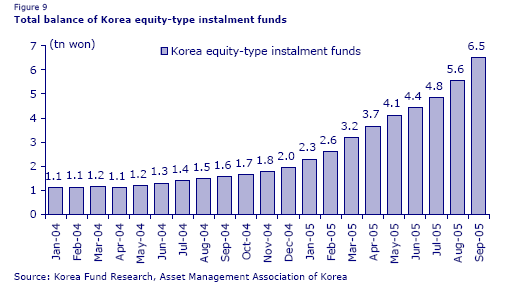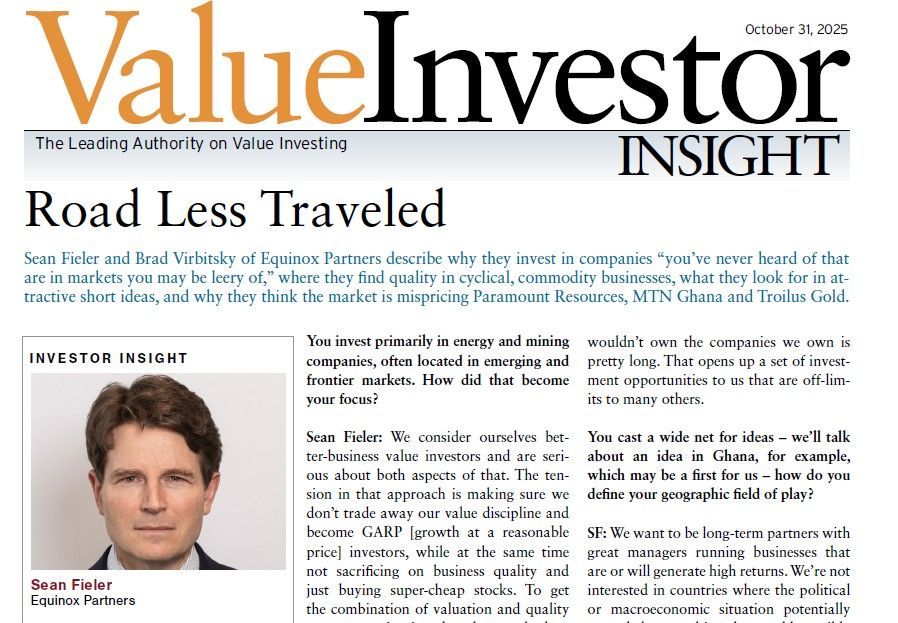Kuroto Fund, L.P. - Q3 2005 Letter
Dear Partners and Friends,
Americans Buy Asian Stocks
It is the underlying premise of Kuroto Fund that extraordinary businesses in the rapidly growing Asian context, trading at significant discounts to their intrinsic value and denominated in meaningfully undervalued currencies, compound into an exceptional investment opportunity. As a consequence of these factors, we have long maintained that a portfolio of Asian stocks, such as ours, is manifestly more attractive than a comparably well chosen portfolio of American stocks. Of late, a growing fraction of American investors appear to be coming around to our point of view. From January to August of this year, international funds, especially Asia specific funds, netted almost twice the inflows of their domestic counterparts. In the month of August, the disparity became even more pronounced. That month domestic U.S. equity mutual funds lost $1.92 billion to withdrawals while world equity funds (again with a large Asian exposure) took in a cool $8.22 billion.
This year’s shift into foreign equities coincided with a period of U.S. dollar strength--- a surprise to us, as we had thought a dollar decline would be the initial catalyst for this change. The absence of a clear macroeconomic cause behind this shift in fund flows raises the possibility that the recent diversion of U.S. equity capital abroad is largely a response to the past few years of outperformance in Asia and global emerging markets. In other words, the new fund flow data may simply be revealing the old American habit of “performance chasing.” If this is indeed the case, and weak hands are holding a growing fraction of emerging market securities, what will happen should the world’s economy catch a slight chill? Will we see the same “flight to quality” patterns we saw in the late 1990s, i.e. the general liquidation of emerging market holdings and currencies as frightened capital comes back to the relative safety of developed markets?
There is reason to believe that this time, at least for Asia’s markets, may be different. (We make this statement advisedly, knowing full well just how infrequently such things ever actually do prove to be different.) Today, America, not Asia, is the locus of financial excess. If global investors do become significantly more risk averse, as they invariably will in a crisis, Asia with its depressed currencies, political stability and low equity valuations could prove to be amongst the best places to preserve capital. Other emerging market regions which have not so carefully managed their economies, currencies and banking systems will likely be subject to the capital flight, currency correction and interest rates spike scenario which from time to time plagues these economies.
Asians Buy Their Own Stocks
Local investors in Asia have begun to allocate more capital to their own equity markets. This shift in Asia’s investment patterns is not, in our estimation, a product of performance chasing, but instead is a reaction of local investors to their structural underinvestment in their own stock markets. Nowhere is this nascent trend more exciting than in Korea, which is also, not coincidently, the cheapest Asian market. The Koreans simply do not own their own stocks in any size.
“First, equities account at present for only 7% of Korean households’ total financial assets of 1,124tn won. Second, equities account for only 4% of the 2,599tn won of total financial assets held by financial institutions as banks and insurance companies continue massively to prefer bonds. In this sense Korea represents one of the more extreme examples of what should be a clear trend for all of Asia, from Japan down, for the next decade. That is a massive potential for a huge asset allocation switch from cash and bonds to equities” (Chris Wood Greed & Fear October 6, 2005)
In December 2004, Korea enacted the “Employee Retirement Security Act.” The thrust of this new legislation was to implement a segregated corporate retirement system not dissimilar to America’s 401K system. Starting from a very low level, a growing percentage of Korean workers have been converting to these new defined contribution retirement plans. Importantly, Korean workers are choosing to allocate a significant percentage of these rapidly growing 401K style plans to equities. Korean individuals, it seems, recognize that low interest rates and very low stock valuations make the latter more attractive than the former.
Like Korea, in India locals have barely begun to embrace their own stock market. Indian equity mutual fund assets are only half the size of local fixed income funds, and the dominant government owned life insurance company has only eight percent of its assets invested in stocks. Even more revealing, the entirety of India’s pension fund system still has a zero equity weighting as mandated by law! Despite the substantial rally in Indian stocks over the last few years, a sizable shift of local investors’ funds into equities could push valuations still higher.
Kuroto’s Accounting System
In light of the recent hedge fund and prime broker scandals, we felt a brief discussion of our own accounting procedures was in order.
- Pricing- Equities price daily at market. Hedges and OTC options are priced exclusively by our counterparties.
- Trading- All trading is done with true third parties. We do not own, nor are we associated with, any particular broker-dealer.
- Net Asset Value (NAV)- The fund’s NAV is calculated on a monthly basis by Cogent Management Services. Cogent is a true third party that provides NAV calculation services to over one hundred other hedge funds.
- Audit- Anchin, Block & Anchin (ABA) audits our books & records quarterly. ABA, a mid-sized reputable accounting firm in New York City, is a true third party.
- Prime Brokerage- Kuroto is primebrokered with Goldman Sachs and Kleinwort Benson (Channel Islands) Limited. Should the primebrokerage services of either Goldman Sachs or Kleinwort Benson suffer a meaningful disruption our ability to operate would also be impaired.
Sincerely,
Sean Fieler
William W. Strong










